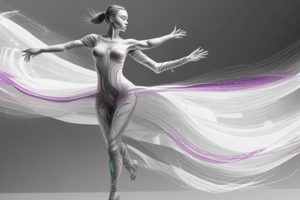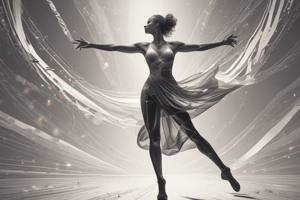Podcast
Questions and Answers
The configuration of body parts is referred to as ______.
The configuration of body parts is referred to as ______.
bodily shapes
Movements that are smooth, continuous, and controlled represent the ______ quality of dance energy.
Movements that are smooth, continuous, and controlled represent the ______ quality of dance energy.
sustained
The energy that is explosive or sharp, in contrast to sustained movements, is known as ______.
The energy that is explosive or sharp, in contrast to sustained movements, is known as ______.
percussive
Movements that consist of trembling or shaking are categorized as ______.
Movements that consist of trembling or shaking are categorized as ______.
In dance timing, movements can be executed in varying ______.
In dance timing, movements can be executed in varying ______.
The quality of dance energy that becomes relaxed and follows an arc in space is called ______.
The quality of dance energy that becomes relaxed and follows an arc in space is called ______.
Movements that are perched in space, like holding a raised leg, are examples of ______ movements.
Movements that are perched in space, like holding a raised leg, are examples of ______ movements.
The use of varied dance ______ helps to minimize monotony in performances.
The use of varied dance ______ helps to minimize monotony in performances.
The quality of movement that refers to the energy and force used in dance is called ______.
The quality of movement that refers to the energy and force used in dance is called ______.
The physical forms created by dancers during a performance are known as ______.
The physical forms created by dancers during a performance are known as ______.
The way a dancer occupies the performance area is referred to as dance ______.
The way a dancer occupies the performance area is referred to as dance ______.
The rhythm and pace at which movements are executed in dance is called ______.
The rhythm and pace at which movements are executed in dance is called ______.
When two or more dancers perform contrasting movements simultaneously, it is described as ______.
When two or more dancers perform contrasting movements simultaneously, it is described as ______.
A dance that is characterized by a clear beginning, middle, and end is considered ______.
A dance that is characterized by a clear beginning, middle, and end is considered ______.
An essential element of dance that dictates the speed of movements is called ______.
An essential element of dance that dictates the speed of movements is called ______.
The dynamic quality of a dance that reflects the amount of tension or relaxation in movements is part of the ______.
The dynamic quality of a dance that reflects the amount of tension or relaxation in movements is part of the ______.
One of the elements of dance is ______, which refers to the configurations created by the human body during movement.
One of the elements of dance is ______, which refers to the configurations created by the human body during movement.
The qualities of dance energies can include ______, which captures the intensity and mood of the performance.
The qualities of dance energies can include ______, which captures the intensity and mood of the performance.
______ in dance refers to the level of force or effort applied to movements, impacting the overall energy.
______ in dance refers to the level of force or effort applied to movements, impacting the overall energy.
The area occupied by dance performers and their movements is referred to as ______.
The area occupied by dance performers and their movements is referred to as ______.
______ is an important element in dance that relates to the duration and rhythm of the movements.
______ is an important element in dance that relates to the duration and rhythm of the movements.
In dance, the interaction of ______ allows for creative expression through the shapes formed by dancers together.
In dance, the interaction of ______ allows for creative expression through the shapes formed by dancers together.
An element of dance, ______ can be identified by how dancers use their bodies in relation to each other and the performance space.
An element of dance, ______ can be identified by how dancers use their bodies in relation to each other and the performance space.
______ refers to how dancers vary the speed and flow of their movements to create distinct effects in their performance.
______ refers to how dancers vary the speed and flow of their movements to create distinct effects in their performance.
Flashcards are hidden until you start studying
Study Notes
Space
- Performers can move forward, backward, diagonally, circularly, etc.
- Size of movements can vary based on smaller or larger actions.
- Movements can be done in a high, medium, and low level.
- Performers can focus their attention by looking in different directions.
Time
- Movements in dance can be executed at varying tempos (speeds).
- Performers move within the tempo of an underlying sound known as a beat or pulse.
Dance Energies
- Movements are propelled and initiated by energy or force.
- Many different types of energies are used in dance.
Sustained
- Movements are smooth, continuous, and flow with control.
- There is no clear beginning or end.
Percussive
- Movements are explosive or sharp.
- They are accented with a thrust of energy.
- They have a clear beginning and ending.
Vibratory
- Movements consist of trembling or shaking.
- They are a faster version of percussive movements that can produce a jittery effect.
Swinging
- Movements trace a curved line or an arc in space.
- Movements are relaxed with downward motion, followed by an upward application of energy.
Suspended
- Movements are perched in space, appearing to hang in the air.
- Holding a raised leg in any direction is an example of a suspended movement.
Collapsing
- Movements involve releasing tension and gradually or abruptly giving in to gravity.
- A slow collapse can be described as a melting or oozing action in a downward direction.
Bodily Shapes
- This refers to how the entire body is positioned in space or the configuration of body parts.
- Shapes can be abstract or meaningful but must contain certain qualities to make the choreography effective.
Characteristics of a Good Dance
- Unity
- Continuity and Development
- Variety and Contrast
- Transition
- Repetition
- Climax
Unity
- The interconnected phrases of the dance are coherent and flow smoothly.
- The movements fit together with each one playing a role that contributes to the whole dance.
Continuity and Development
- The structure of the dance is organized progressively, making each movement phrase move naturally into the next.
- There is a continuous development of the movement phrases, ensuring that the audience is engaged until the end.
Variety and Contrast
- Variety and contrast in movement phrases make the dance more interesting and engaging.
- Changing the direction, use of energy, and timing of movement helps to avoid repetition and maintain the attention of the audience.
Transition
- This is the link between movements, phrases, and sections of the dance.
- It makes the dance flow smoothly by creating a logical progression.
- This is important for ensuring unity of the dance.
Repetition
- Certain phrases may be repeated in choreography so that the audience can see and understand those movements again.
- Repeated phrases and sections usually represent the main message of the dance.
Climax
- This is where the apex of energy in the dance is reached.
- Similar to the climax in a story, it is the culmination of a series of events.
- The climax can be a fast, energetic burst of action or a more gradual and subdued ending.
- Music helps both the choreographer and audience to understand this important moment of development.
Choreographic Forms in Dance
- Sequential
- Contrapuntal
- Episodic
- Nature and Brief History of Dance
- Benefits of Dance
- Elements and Characteristics of Dance
- How to Appreciate and Evaluate a Dance Performance
What is Dance?
- At its core, dance is an art, the art of body movement.
Nature of Dance
- It differentiates itself from athletics and other daily activities by its focus on aesthetics and entertainment.
- People dance for various reasons:
- To please the gods
- To please others
- To please themselves or express themselves
- To build a sense of community
Brief History of Dance
- It's believed that the first use of dance was as a gesture for communication.
- Examples of how dance has been used throughout history:
- As a means of religious expression (e.g., Ancient Egypt)
- As an aid to military training (e.g., Ancient Greece)
- Greeks believed grace in dance equaled prowess in war, so they incorporated dance into education.
- As a way to express tribal unity (e.g., Philippines)
- As a courtship ritual (e.g., Philippines)
Benefits of Dance
- "Dance is fun! It lifts the spirit, strengthens the body, and stimulates the mind." - Wayne Sleep
Main Benefits of Dance
- Physical
- Mental/Emotional
- Social
- Cultural
Physical Benefits of Dance
- Develops cardiovascular and muscular endurance
- Improves flexibility, balance, coordination, and body composition
- Enables joint mobility
- Helps to prevent osteoporosis
- Lowers the risk of cardiovascular diseases
Mental/Emotional Benefits of Dance
- Helps to keep the brain sharp
- Decreases the risk of dementia and Alzheimer's disease
- Reduces depressive symptoms
- Improves self-esteem and body image
- Aids in releasing emotional tension
Social Benefits of Dance
- Gives a sense of togetherness within a group
- Encourages positive social interaction and relationships within a group
- Contributes to the individual's potential for self-actualization in society
Cultural Benefits of Dance
- Promotes cultural values
Studying That Suits You
Use AI to generate personalized quizzes and flashcards to suit your learning preferences.




